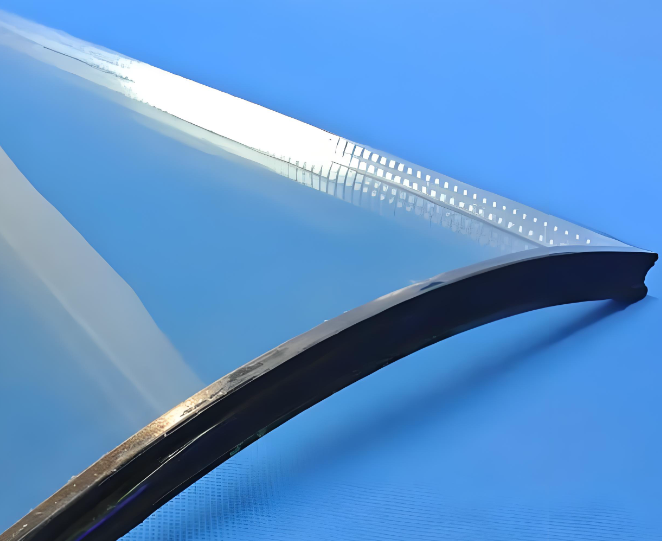Transparent heater is used in cameras, displays, optical sensors, freezers, and safety systems that must stay clear in humid or cold environments. They look simple from the outside, but their performance depends on several electrical parameters. One of the most important of these is insulation resistance.
Understanding insulation resistance helps you choose a safe, stable, and long-lasting heater that performs well under moisture, high humidity, and outdoor conditions.
Insulation resistance is a measure of how effectively a heater prevents electrical current from leaking through its insulating layers. It shows how well the heater separates the conductive layer from the outside environment.
A transparent heater typically has:
These layers must work together to stop current from escaping into the environment—especially when the heater encounters moisture, humidity, or direct contact with cold surfaces.

A megohmmeter applies a DC voltage—commonly 100V, 250V, or 500V—between the heater’s conductive pattern and an external reference. It then measures leakage current.
The result is expressed in:
Higher insulation resistance means the heater is electrically safer and more stable, especially when used in wet or humid environments. And vice-versa, lower values mean higher leakage risk.
Transparent heaters are often installed in harsh environments:
Fog forms when humid air meets cold glass. The heater solves this by warming the surface. But if moisture enters the heater structure or condensation seeps into edges, insulation resistance can drop dramatically.
If insulation resistance is too low, risks include:
A heater that performs well in a dry lab may fail quickly in a humid environment if insulation resistance was not properly designed. This is why engineers treat insulation resistance as a key parameter for reliable fog-prevention.

Transparent heaters fall into four broad categories based on insulation strength. The ranges below match common ITO, metal mesh, nano-silver, and hybrid coated heaters used in global industries.
| Range (MΩ) | Performance Level | Suitable Environments | Typical Applications |
| ≥10 MΩ | Standard | Indoor, dry areas | Indoor HMIs, lab panels |
| 50–100 MΩ | Mainstream | Outdoor but moderate humidity | CCTV housings, drones |
| 100–200 MΩ | High Grade | Heavy fog, large temperature swings | Traffic cameras, freezer doors |
| 200–500 MΩ | Premium | Washdown, steam, continuous humidity | Food factories, marine, railway cameras |
Most transparent heaters on glass fall inside 50–200 MΩ, while premium designs push above 200–500 MΩ for harsh environments.
Several design and environmental factors influence insulation resistance. Below are the most important ones.
1. Thickness of the insulating substrate
A thicker film (PET, PC, glass) increases insulation resistance.
Typical thickness:
More thickness = better insulation, but too much thickness may reduce transparency or flexibility.
2. Adhesive and lamination method
Optical adhesives (OCA) and pressure-sensitive adhesives (PSA) influence moisture resistance.
High-quality adhesives maintain:
Lower-grade adhesives absorb moisture and reduce insulation resistance quickly.
3. Edge sealing quality
Most insulation failures come from moisture creeping in through the heater’s edges. A strong sealing design—using epoxy, silicone, or UV adhesives—keeps the internal layers protected from water vapor. Good edge sealing is often the deciding factor for long-term durability.
4. Environmental exposure
Environments with any combination of the following will lower insulation resistance faster:
Outdoor railway environments are particularly tough, requiring higher insulation levels.
5. Operating voltage and power density
Higher voltage heaters require:
For example:
A heater running at 48V needs higher insulation than one running at 12V.
The insulation resistance you need depends on how much moisture, temperature cycling, and outdoor exposure your transparent heater will face. For indoor devices such as HMIs, display windows, or light-duty machine vision systems, an insulation level of 50–100 MΩ is typically enough. These environments have mild humidity, so the electrical stress on the heater is relatively low.
For applications exposed to condensation or outdoor conditions, higher insulation is necessary. Machine vision cameras, industrial sensors, vehicle-mounted cameras, and outdoor surveillance systems work more reliably with 150–300 MΩ, as they encounter humidity, rain, and fast temperature changes. Cold-chain equipment, such as freezer doors or refrigerated display glass, also performs better with 200–300 MΩ due to constant condensation and frost cycles.
Different industries deal with different challenges such as fog, frost, chemical cleaning, steam, or rapid temperature changes. Below is a detailed comparison of recommended values.
| Industry / Application | Environmental Stress | Recommended Insulation Resistance |
| Indoor HMI / Displays | Low humidity | 10–50 MΩ |
| Outdoor CCTV Security Cameras | Rain, fog, dew | 50–100 MΩ |
| Drone Camera Windows | Altitude changes, moisture | 80–150 MΩ |
| Automotive ADAS Cameras | Frost, snow, car wash | 100–200 MΩ |
| Traffic Cameras | Year-round humidity cycles | 120–200 MΩ |
| Freezer & Refrigerated Doors | Frost, condensation cycles | 150–250 MΩ |
| Food Factory Observation Windows | Steam, washdown, cleaning chemicals | 200–500 MΩ |
| Marine Vision Systems | Salt mist, heavy moisture | 250–500 MΩ |
| Railway Cameras | Rain, vibration, thermal shock | 200–500 MΩ |
In a word:
1. What test voltage is normally used?
Most insulation tests use 100V or 500V DC, depending on the heater’s voltage and application.
2. Does insulation resistance drop over time?
Yes. Humidity, condensation, and poor sealing can lower insulation resistance gradually.
3. Should I choose a higher insulation value for outdoor use?
Absolutely. Outdoor heaters face moisture and temperature cycles that demand higher insulation.
4. What is the minimum insulation resistance for 24V and 48V systems?
24V → ≥ 100 MΩ
48V → ≥ 200–300 MΩ
5. Does higher insulation resistance increase cost?
Slightly, but it greatly improves safety and lifespan—worth the investment.
Simply drop your email or phone number in the contact form, and we'll promptly reply you shortly.